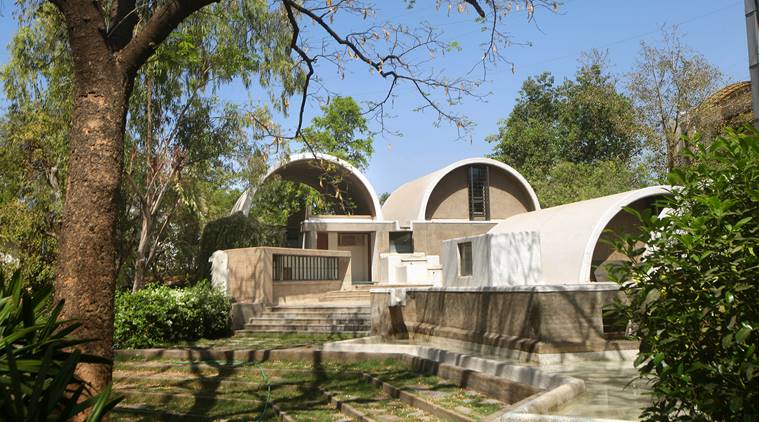Written by Shiny Varghese |Updated: March 5, 2019 8:43:52 am
Celebrating the work of the Pritzker Prize awardee, Doshi, is an exhibition in Germany at the Vitra Design Museum
Organised by the museum with the Wustenrot Foundation, curator Khushnu Panthaki Hoof presents 26 projects in the show titled “Balkrishna Doshi: Architecture for the People”.

I live in paradoxes. As a result, there is a constant struggle to confine, to find security, to create walls around and then try to open them without windows and doors, to see outside or go out. The choice I make is to be in and out at the same time,” says Balkrishna Doshi, in his book Paths Uncharted. In Sangath, his studio in Ahmedabad, he explores abstract ideas of what a building is, of form and formlessness, with vaults embedded into the ground. Entering it, one almost feels like going into a cave. Conceptualised with artist MF Husain, in Amdavad Ni Gufa, he questions the need for a foundation. Why is a roof always flat, he asks.
Celebrating the work of the Pritzker Prize awardee, Doshi, is an exhibition in Germany at the Vitra Design Museum, from March 30 till September 8. Organised by the museum with the Wustenrot Foundation, curator Khushnu Panthaki Hoof presents 26 projects in the show titled “Balkrishna Doshi: Architecture for the People”. The venue
itself, designed by well-known America-based architect Frank Gehry, is one of the world’s leading institutions dedicated to design. “The Vitra Design Museum is a beautiful space with variety of scales and light conditions. I have tried to integrate another layer of experience by adding colours, creating vistas and play of scale,” says Khushnu. This is Doshi’s first retrospective outside Asia.
itself, designed by well-known America-based architect Frank Gehry, is one of the world’s leading institutions dedicated to design. “The Vitra Design Museum is a beautiful space with variety of scales and light conditions. I have tried to integrate another layer of experience by adding colours, creating vistas and play of scale,” says Khushnu. This is Doshi’s first retrospective outside Asia.
Khushnu presents four themes in the exhibition. While “Shaping an Integrated Education” presents Doshi’s experiments on how spaces induce awareness and reinforce learning, one is keenly aware of his well-known strategies in School of Architecture (now CEPT University) where there are no doors, affirming his belief that “there are no boundaries of space and time in learning”. The second theme of “Empowering People — Home and Identity” raises questions about what makes a home a home. “Shouldn’t people and lifestyles be the guiding principles of a design that can provide freedom and identity for its inhabitants?” questions Khushnu. In the next theme, “Building Academic Institutions”, she curates examples of how architecture can enrich dialogue between users and nature. Lastly, through the theme “Creating a Liveable City”, Doshi’s projects raise questions about “how, if woven together in an appropriate manner, planning principles and public cultural institutions can change citizens’ mindsets and eventually
improve the quality of urban life.”
improve the quality of urban life.”
The monograph, which will be released at the exhibition, will display Doshi’s projects across seven decades, with essays by critics and architects, including Kenneth Frampton, Juhani Pallasmaa, Hans Ulrich Obrist, Martha Thorne, Rajeev Kathpalia, Samanth Subramanian and Kazi Ashraf. It will also have photographs by Iwan Baan and Vinay Panjwani, and Doshi’s travel sketches.
“The varied projects that have been selected for the exhibition demonstrate different approaches and experiments with one common concern of providing opportunities and improving the life of people in India through housing, educational institutions, planning and public buildings. The works are approachable and grounded in their physical manifestation while being contextual and sustainable,” says Khushnu.
Doshi’s Aranya, a low-cost housing project in Indore, which won him the Aga Khan Award for Architecture in 1995, is a case in point. Not only did he integrate different income groups but also gave them the incremental agency to build their own spaces as the resources and need grew. It became a global model of self-help housing thereafter.






















No hay comentarios:
Publicar un comentario